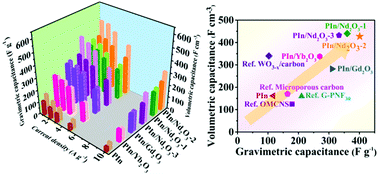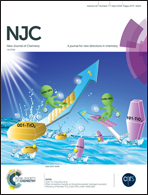Rare earth metal oxide (RE2O3; RE = Nd, Gd, and Yb) incorporated polyindole composites: gravimetric and volumetric capacitive performance for supercapacitor applications†
Abstract
Incorporation of rare earth metal oxides in the polyindole (PIn) matrix seems to be an effective way for improving the electrochemical and stability features of PIn. PIn being a member of the fused aromatic molecular structural family draws attention as a potential electrode material for supercapacitors. Incorporation of rare earth metal oxides improves the gravimetric performance of PIn by introducing additional pseudocapacitance and also exhibits fair volumetric capacitance owing to its high packing density. PIn composites with RE2O3 (RE = Nd, Gd, and Yb) show augmented gravimetric and volumetric capacitance. An Nd2O3 incorporated PIn composite with a ratio of 1 : 1 exhibits an enhanced gravimetric capacitance of 401 F g−1 and a volumetric capacitance of 516 F cm−3. This composite also exhibits markedly enhanced values of cyclic stability, coulombic efficiency, power density, and energy density. The established synergy between RE2O3 and PIn together with structural modifications results in much improved electrochemical properties of the developed composites.



 Please wait while we load your content...
Please wait while we load your content...